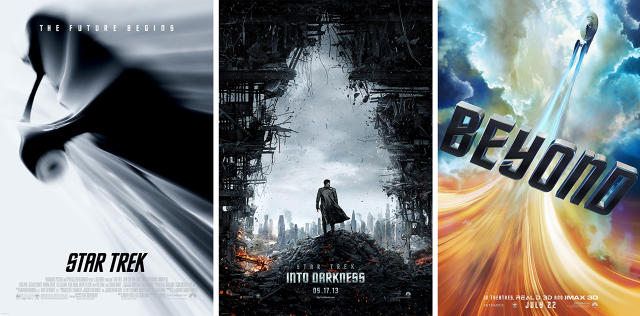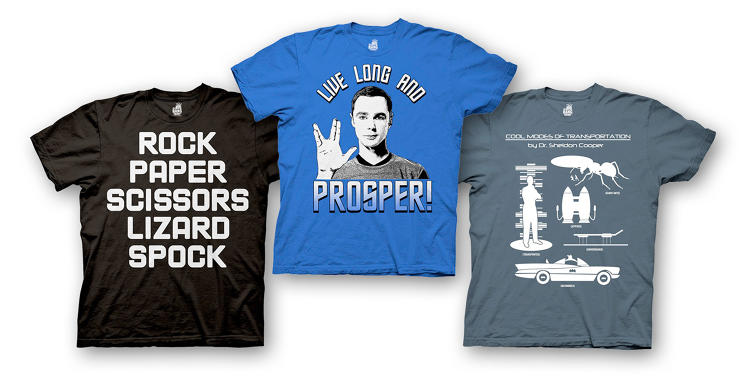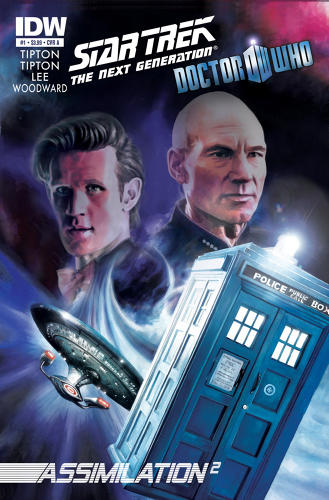“Star Trek” at 50: Mining Its Past, Exploring Its Future, And Giving Fans Presents
Star Trek really is the least likeliest cultural institution. It was a short-lived, low-rated television show that debuted to mixed reviews in 1966. By the end of its low-budget third season, the show was dead, and even letter-writing campaigns from fans who had rescued it once before couldn’t save it.
Somehow, after 10 years of syndication (and one season of a short-lived animated series), Star Trek found its audience. By 1979, that audience was sizable enough for a movie—Star Trek: The Motion Picture—which broke box office records. And thus the franchise was born. Three sequels followed. In 1987, a critically adored television revival called Star Trek: The Next Generation took the concept 100 years into the future. The original cast starred in three more movies, then in 1994 a time-travel plot allowed them to pass the cinematic torch to Patrick Stewart and the cast of The Next Generation for three more movies. The Next Generation was such a hit that it was followed up by two more series—Deep Space Nine, set on a space station during the same time period as TNG, and Voyager, about a starship not named “Enterprise”—premiered in the mid-90s. As Voyager wound down in 2001, a prequel series called Star Trek: Enterprise ran for four years.

The franchise faltered through the years—Star Trek: The Final Frontier and Star Trek: Nemesis were flops, while Enterprise struggled on television, ultimately being canceled in 2005. (Its creator said that, after 750 episodes between the premiere of The Next Generation and the final episode of Enterprise, Star Trek “needs a rest.”)
It got one. By 2009, Star Trek was off of television and was on its way to being a marquee film series. JJ Abrams revived the franchise for the silver screen with a new cast. The new Star Trek was not intended for a niche audience—it was intended to be a blockbuster, and it was. Abrams’ reboot was the highest-grossing Star Trek film of all time. Only a convoluted cameo by Leonard Nimoy, whose appearance indicated that the characters were from an alternate timeline than the original series, connected it to the generations that had come before. A sequel, Star Trek Into Darkness, was a similar box office success, and now a third film—Star Trek Beyond—has just arrived in theaters to critical acclaim.
A Trek For Every Type Of Fan
All of which is to say that there is a lot of history to Star Trek. There are a lot of different things a person could be referring to when they say the words “Star Trek,” even. There are fans who adore William Shatner and Leonard Nimoy, fans who prefer Patrick Stewart and Jonathan Frakes, fans who cosplay as Captain Janeway or who have shrines to Scott Bakula in their bedrooms. There are fans who know the theoretical science behind the warp drive and fans who are hard at work developing a working Tricorder to diagnose real medical conditions. There are fans who don’t care about any of that, and prefer a Star Trek where Chris Pine, Zoe Saldana, and John Cho go on high-octane action-movie adventures. And that poses a unique challenge as Star Trek celebrates its 50th birthday: How do you build an anniversary event calendar that’s for all of those fans?
That’s been the challenge for CBS Consumer Products, which has been planning a massive celebration, with events around the country and around the world, to capture the importance of Star Trek. Liz Kalodner, executive vice president and general manager for CBSCP, knows that giving the fans a chance to be a part of all of this matters. “The fans were the ones that kept Star Trek on the air way back in the ’60s, and the 50th anniversary for us is a little bit of a love letter to those fans,” she says. “We created specifically singular experiences to give them an opportunity to celebrate their love of Star Trek. That really was the impetus and the motivation for our 50th anniversary plan.”
That plan is wide-ranging, and stretches for much of that 50th anniversary year. Star Trek premiered in September of 1966, and while the release of Star Trek Beyond might have kicked up the schedule a bit to capitalize on Trek enthusiasm, the dates more or less match up. The official 50th Anniversary Convention happens in Las Vegas in August, while ReedPOP—which does the New York Comic Con—has been tapped to put together “Star Trek: Mission New York” in September. That’ll be the first official Trek convention in New York (the birthplace of the Star Trek convention) and ambitions are high. For those who want the chance to call William Shatner “Captain” while aboard an actual ship, the Star Trek cruise—a rare opportunity to voyage out to sea with Shatner, as well as Next Generation stars Marina Sirtis and Jonathan Frakes, and more. Fans with a more intellectual bent toward Star Trek might prefer the “Trek Talks” series—a play on TED Talks that features speakers exploring the impact of Star Trek in the real world, from technology to multiculturalism to the space industry to philosophy and more. At New York’s Intrepid Sea, Air & Space Museum, meanwhile, a 10,000-square-foot exhibit called “Star Trek: The Starfleet Academy Experience” simulates what might happen to a recruit joining the fictional space service.
Accepting A Bold New Mission
If that sounds like a lot to take in, well, it’s a lot to plan, too. The process of managing the Star Trek brand is a fairly involved one, according to Kalodner. She’s very aware of what Star Trek means to people, and the impact that it’s had on the world. She notes that the flip phone looked a lot like the communicators created by Gene Rodenberry for the series, and that the pad in The Next Generation bears more than a passing resemblance to the iPad. “Even the holodeck is really virtual reality,” she says, and notes that the Qualcomm Tricorder X-Prize—which aims to make the “Tricorder” diagnostic tool on the show the real-world future of personal medicine—is a partnership that CBS is actively engaged in. “What we call science fiction has become science reality,” she says. “Someone asked me recently what hasn’t been invented yet from Star Trek? Well, I don’t think we can yet beam ourselves up, but who’s to say somebody won’t?” All of that is a responsibility that the people who manage Star Trek take very seriously.
“It’s an honor to do it, and it’s a tremendous responsibility,” she says. “The fans are very loyal, and they are very communicative. We try to serve them well, and they tell us if we’re ever off-base. We have a very extensive product development, product approval process and team to make sure that everything we put out is correct and on-brand, so that we’re honest and true to the franchise.” Every partner who works on a Star Trek product has strict guidelines to follow in terms of creative approach. (Even fans who want to make their own work in the Star Trek world have guidelines to follow now.) And that level of care and attention to detail is especially critical when dealing with the 50th anniversary events.
That’s something that Lance Fensterman, senior vice president at ReedPOP, has taken to heart in planning the event in New York. Getting a Star Trek convention right matters, and in addition to working with CBS, he’s going right to his audience. “The first thing we do is we hire fans, right? The people who work here are fans of what we work on—and then we also ask,” he says. “The wonderful thing about fandom is that they’re really, really happy, and really, really eager, and really, really accessible to sharing. When you ask what fans want, and then you listen, and then you give it to them, your odds of them liking it go up quite a bit.” Fensterman’s group does that sort of work both formally and informally. “We’ll push out through social channels that we’ll be at a bar for a few hours, and you can show up and just tell us what you want, what’s cool, what would be exciting,” he says.

These are fan events, so it makes sense that they’d be fan-centered. But there are challenges that come with that, too. Star Trek conventions go back almost as long as Star Trek does. When Leonard Nimoy appeared in costume as Spock at the Medford, Oregon, Pear Blossom Festival in 1967, the thousands of fans who showed up helped him determine it’d be the only time he ever did that in public—which presumably left the fans who attended the first Star Trek Con in Newark in 1969 a little disappointed. If you’ve got nearly five decades worth of conventions to compete with, the challenges faced by the events in New York and Vegas become: How do you live up to the fact that this one needs to be bigger and better?
Kalodner, for her part, has given that a lot of thought. “We’ve worked quite hard to make this year the best of the best,” she says. “You’ll see pairings of people that haven’t appeared together in a long time, if ever. You’ll see talent that you haven’t seen in many, many years. Everything’s bigger and deeper, in terms of content.”
Fensterman says that, at ReedPOP, they’re very conscious of the history of Star Trek as the originator of the fan convention, and they try to pay that off in how they’re planning the New York event. “What our business is about is understanding fans’ passions, and then giving them really cool experiences that they can share together,” he says. “Once you understand those core things, then it becomes about digging into the nuances and details of the Trek universe that are going to really excite these guys. Star Trek [was] one of the first to really create the super-fan and fan community experience, so to build something 50 years later for that community is a very cool way to build a full-circle experience.”

Total Immersion
Of course, the New York convention is just one of the Trek-themed events. If you’re in the tri-state area and you love Star Trek, shelling out $145 for a weekend of fun is probably a splurge worth taking on. But if you’re truly hardcore, you’ve got things like the cruise to consider. So how do you make sure that the people who go off to sea with Shatner and pals get their money’s worth, too?
“We didn’t want to recreate the convention experience on the cruise,” Kalodner says. “So we’ve themed it out in a way that we have a lot of talent that’s coming, and they’re each going to entertain on the cruise in a different way.” Frakes and Sirtis—who played love interests on The Next Generation—are performing A. R. Gurney’s Pulitzer Prize-nominated drama Love Letters. Shatner is performing his one-man show. Locations from the show will be created onboard the ship, the entirety of which (all 2,200 passengers) will be made up of Star Trek fans. “It will be a totally immersive experience. All of the food will be themed. Everywhere you go will be themed. The conventions, you go in and out, but the cruise, for six days and six nights, you’ll be completely immersed.”
That’s a lot of payoff for fans, and it helps explain one of the challenges that the anniversary celebration is determined to meet. Namely, making sure that the experiences can be deep enough for the hardest of hardcore Trekkies while providing plenty of points of entry for fans whose interest in Star Trek doesn’t extend too much further than the fact that they
really like the reboots.

“We think of the fan base in three segments,” Kalodner says. “We think about core fans. They’re the die-hard, avid collector fans. The second segment is casual fans. They’re people who love Star Trek, but aren’t dressing in costume. They might buy a pizza cutter in the shape of the Enterprise, though. And the third one is what we call emerging fans—that’s the younger demographic who have really come to us via the new movies, and they’re excited about Star Trek. In many cases, some of them will move to ‘core,’ but when you have an experience like the cruise, you really can meet the desires of all three groups because you already have a cruise experience. So you can take a casual approach—you don’t have to go to every single event—or you can immerse yourself completely in it.”
That’s something that ReedPOP has experience in, as well. Fensterman says that they work really hard to ensure that the different “tribes” of Star Trek fan each get met on their own terms. “There are people who are fans of the original, there are fans of TNG, all the way through to the current films. There are tribes throughout all of that, so what we want to do is pull the entire world of it together, and then place it in the context of the general pop culture that Star Trek has influenced, as well. It’s broader, it’s bigger, and it’s kind of the entire world of Star Trek in one place. That’s the goal. We’re pretty good at building these playgrounds where all the different tribes can play together.”









Fast Company , Read Full Story
(32)














